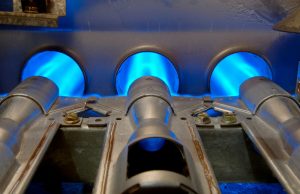
Safety is a vital part of all the jobs we do for our customers. When we fix a natural gas furnace in a house, we don’t just ensure that it will come on, provide heat, and operate at energy-saving levels. We also make sure it runs as safely as possible. Although gas furnaces are built with the same priority on safety that we use in our work, it is possible for the combustion byproducts from the furnace—which include carbon monoxide, nitrogen dioxide, and sulfur dioxide—to accidentally enter living spaces. These are toxic gases and create many serious, life-threatening health hazards.
You’re probably aware of what high concentrations of these gases do. But the safety concerns aren’t only about a large amount of combustion byproducts flooding into a home. There’s also the risk of chronic exposure to low levels. The symptoms aren’t as obvious, but over the long-term can be just as dangerous, especially to infants and the elderly. The main reason for the low-level presence of combustion byproducts is a furnace that is venting poorly.
The Furnace Flue and You
A gas furnace uses combustion gases to heat up a metal container called a heat exchanger. Once the heating cycle is finished, the byproducts left in the heat exchanger are vented out through a chimney to let the gases escape up through the top of the house. Unfortunately, blockage or backdraft can prevent proper venting, pushing some of the toxic gases into the house.
- Blockages: The flue of a furnace can become blocked for a variety of reasons, but the most common is decaying tiles and mortar inside the chimney. The opening of the chimney on the roof needs to be properly capped to prevent rainwater and moisture from getting inside the flue and accelerating the deterioration.
- Backdraft: This is what happens if a furnace doesn’t get enough air. A lack of oxygen drags air down the chimney to make up the deficit. The air blowing down through the chimney prevents combustion gases from escaping up it.
These problems can develop over time because of an aging furnace, lack of routine maintenance, or neglected repairs. But they’re also common if the furnace was badly installed in the first place. Professionals test the amount of venting a gas furnace needs and make sure that their installation meets these safety requirements. This is yet another reminder to only have licensed professionals handle any heating installations.
We recommend occasionally checking for signs of poor ventilation. Rust on the furnace grill can mean vapor moisture is flowing the wrong direction. You might also see condensation on the inside of your windows in the morning, which is also a result of backdrafting. Keep carbon monoxide detectors in the house and always respond to them when they go off. And never miss out on regular professional furnace maintenance: flue problems are one of the main things our technicians look for!
For a Bossier City, LA HVAC contractor who can handle the furnace repair or maintenance services you require, turn to us!
Call the Doctor of Home Comfort—and Home Heating Safety! Hall’s Heating, Air Conditioning & Refrigeration.


